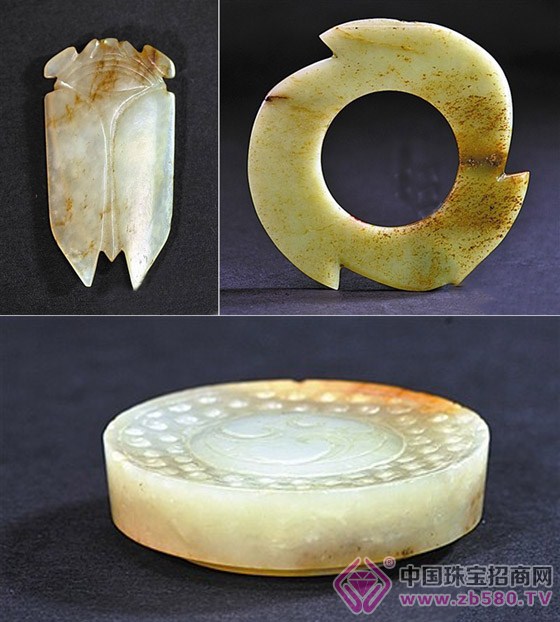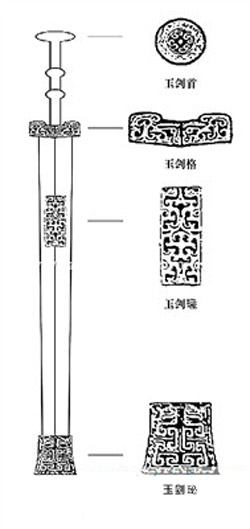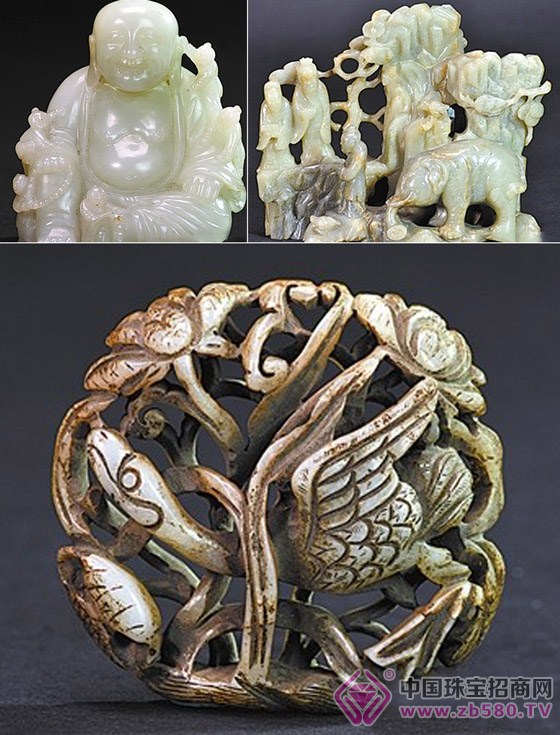Story in the Geography Museum
From April 9th ​​to July 10th, at the Dalian Modern Museum, the "Heaven and Earth Elf - Wuhan Museum Collection of Jade Products Exhibition", the jade articles on display are ancient, down to the Ming and Qing Dynasties, rich in variety and high quality. The Holy Spirit - ceremonial jade, "Qiao Tiangong - furnishings jade", "warm and beautiful - jade decoration" three parts, with more than 100 pieces of exquisite jade interpretation of the profound connotation of the jade ware known as "the heaven and earth elves" . Today is the World Museum Day. Let us follow Liu Junyong, a professor at Liaoning Normal University and an archaeological expert, to learn about the profoundness of Chinese jade culture.
8000 years ago
Jade appeared as a jade
Symbol of identity and status
China is one of the first countries in the world to make and use jade articles.
As early as 8,000 years ago, the jade wares of the Xinglongtun culture in the Xilamulun River Basin have appeared, mainly the jade and the jade, which are worn on the ears. When jade appears, it is not a simple production tool or ornament, but a symbol of the identity and status of the jade.
After the Xinglongyu culture, the jade wares of the late Hongshan culture reached its peak more than 5,000 years ago. “Jade is a burial†has become a feature of the funerary of the Hongshan culture.
A little later is Liangzhu Culture, which is mainly distributed in the Taihu Lake Basin. Its jade articles are mainly ç® and ç’§, and the tombs are covered with jade and enamel, which are called “Jade burialâ€.ç® is a cylindrical jade that is outside the inner circle, meaning “the place of heaven and earthâ€.
The Liangzhu culture jade displayed on this exhibition is divided into two sections by a horizontal line. Each section uses four corners as the center line of the human face. Eight simplified emblems are engraved on the four sides of the groove, in two rows. The ribs engraved with parallel lines symbolize the "crown crown" worn by God. The eyes are engraved with a circle, and the corners of the square are used as the mouth. It runs through the upper and lower sides and plays the role of the heavens and the earth. This kind of god emblem is engraved on many jade plaques of Liangzhu culture. Even on the jade that symbolizes the kingship, the god emblem is also engraved to show that the kingship is also subject to God's supervision. Most of the jade found in the Neolithic archaeological culture in China belong to the artifacts used by the Wusong, which is of great significance in the process of Chinese civilization. This jade is embedded in a hole in a hole with a round-shaped copper box, which is equipped with a hollowed-out Passionflower cover and used as a smoker.
4500 years ago - 4200 years ago
Dalian has become

The area with the most unearthed gums
The jade (gum) displayed on this exhibition is the largest one known at present. At the end of the Qing Dynasty, Wu Dazhao first called this kind of round hole and the object with three teeth around it, which is suspected to be an accessory for astronomical instruments. Most of the academic circles are now called gums.
The gums first appeared in Dalian and Shandong at the southern end of the Liaodong Peninsula, and found gums more than 5,000 years ago in Wangjia Village, Lushun, Dalian, Xiaozhushan Site in Changhai Guanglu Island and Dawenkou Cultural Tombs in Shandong. In the Longshan era, from 4,500 to 4,200 years ago, Dalian has become the area with the most unearthed gums, and 9 pieces were unearthed in Siping Mountain and the adjacent Goryeo City. In recent years, the Northeast team of the Institute of Archaeology of the Chinese Academy of Social Sciences has unearthed three more in the excavation of the Anshan Mountain. According to the "Study on the Stonebacks of Siping Mountain in the Liaodong Peninsula", the gums are all from the chest of the human bone. It can be seen in the same way as the jade pig dragon unearthed from the Hongshan culture. The artifact worn.
Since entering the Shang and Zhou dynasties, jade has been included in the national system of rules. "Using jade as a six-piece", that is, ç’§, ç®, åœ, ç’‹, ç¥, ç’œ; "the four sides of the ritual of the heavens and the earth" is called "six rui", to 璧礼天, to ç®ç¤¼åœ°, to åœç¤¼ä¸œæ–¹, Hu, the West, to the south of the ritual, to the north. The jade displayed on this exhibition is one of the "Six Rui". The jade can also be compounded into a ring or a ring. The jade of the Western Zhou Dynasty follows the style of the Shang Dynasty and develops into a set of decorative pieces.
1. Liangzhu Culture
2. Han Dynasty grain jade
3. Han Dynasty Yuxi
4. Han Dynasty Yu Jian
5. Warring States to the Han Dynasty jade sword
6. Warring States to the Han Dynasty Yu Jian
7. Warring States to the Han Dynasty Yu Jian
8. Han Dynasty jade sword sketch
9. Qing Dynasty jade "five sons Dengke" ornaments
10. Qing Dynasty jade " elephant farming bird" ornaments
11. From the end of the Yuan Dynasty to the early spring of the Qing Dynasty
The influence and identity of the later generations of the Han Dynasty

The Han Dynasty jade exhibits on this exhibition include typical grain crepe, enamel and sword ornaments.
Yuxi first appeared in the Neolithic Age. In the history, the jade can be divided into three types: one is the crown embedded in the hat; the second is the one with the hole; the third is the cockroach placed in the mouth of the deceased. Since the Han Dynasty, the world has been more likely to be born again. Put the jade in the mouth of the deceased, meaning that the spirit is not dead, resurrected and resurrected. If you put it on your body, it means Gao Jie. "Historical Records, Qu Yuan, Jia Sheng Biography" has the words "è‰, 蜕 秽 秽 秽 秽 秽 秽 秽 秽 秽 æµ® æµ® æµ® æµ® æµ® 。 。 。 。 。 。 。 。 。 。 Therefore, Yuxi is not only the decoration of the living, but also the burial jade of the deceased, that is, "birth is thought to be admired, death is thought to be contained." The unearthed frequencies of the jade in the Han Dynasty were quite high, and most of them were contained. Not only were the tombs unearthed in the tomb of Wang Hou, but they were also unearthed in the tombs of the civilians. In the Han Dynasty, the method of making jade was simple, and the number of knives immediately showed the dagger, belly, back and wings. It was called "Han Ba ​​Knife", which had an important impact on later generations. As for the ancients who believed that drinking and not eating, it is a misunderstanding. It is to rely on sucking sap to sustain life and is harmful to trees.
The jade sword ornaments from the Warring States Period to the Han Dynasty exhibited a clear understanding of the Han Dynasty jade swords. The jade sword is a sword decorated with jade, such as the sword head and the hilt. It consists of four parts: jade, jade, jade and jade. It is the most luxurious decoration in the ancient sabre. The combination of jade and sword has already appeared in the Western Zhou Dynasty. In the late Spring and Autumn Period and the Warring States Period, the jade swords of the first, the grid, the pipa, and the pipa were gradually formed. In the Western Han Dynasty, the jade sword became the sword of the emperor's aristocracy, and it was also a symbol of social identity at that time. After the Wei and Jin Dynasties gradually disappeared In the Han Dynasty, the jade sword was a gift between the emperors and nobles. A group of jade swords unearthed from the tomb of Liu He in Nanchang Haifu Hou, some of which should be gifts, and Yu Jianyi is the most gifted sword.
The Ming and Qing Dynasties pursue the fine decoration and decorative style

The most exhibited in the exhibition was the jade articles of the Ming and Qing Dynasties. In the Ming and Qing Dynasties, the jade articles gradually separated from the traditions of the five generations and the two Songs, and they formed a style of pursuing fine carvings and decorative decorations. Antique jade articles also appeared in large numbers. On display, the "Five Sons" decoration of the jade ornaments is carved with a smile, a Maitreya Buddha holding the beads and five boys climbing on both sides of the Buddha's body, meaning "Five Sons". The characters are very dynamic and lifelike.
Shanzi is a kind of jade carving decoration craftsmanship. The main themes are landscape characters, requiring producers to have higher styling ability, creative thinking ability and higher literary and artistic accomplishment. The "Like-Ploughing Birds" mountain show on the show is based on a legend: When it was said that when the government was in power, the mountains were fertile and the people were competing to come to this place. Everyone often fought, and the land was divided equally among the people, and they were on the wasteland. Everyone was moved, so they no longer struggled and politely greeted each other. The matter touched the gods, and they moved to the mountain to help the building houses and the plows to open up wasteland. After the crops emerged, the bird clusters cleaned the weeds. At that time, he was choosing a successor. After hearing this, he took the entourage to visit him. The two people on the left side of the mountain on the left side of Yushanzi are the envy and the followers. Later, the rumor was located in Yu.
The landscape poem "Zigang Brand" exhibited in this exhibition is the work of Lu Zigang, a famous jade carving master of the famous "Wu Men" (now Suzhou) in the Ming Dynasty. Lu Zigang is a man of Ming Jiajing and Wanli. His jade pendants are shaped like squares or rectangles. They are generous and honest, and they are called "Zigang Brand". This piece of jade is rectangular, with the first dragon carving on the top, the bas-relief on the side of the brand, the willow, the boat, and the other side of the book, "Where is the fishing boat, the willow bank" and the "Zigang", each has a top and a bottom. Can be worn with a pair of small round holes.
Chunshuiyu and Qiushanyu are the themes of Qidan and Jurchen in the Liao and Jin Dynasties. The so-called spring water jade refers to the jade carving of the swan (鹘海海é’); the so-called autumn mountain jade refers to the jade that is the theme of the mountain forest tiger deer. The former coincides with the hunting and hookfish activities of the Liao Emperor's "Spring Festival" to "Duck River" recorded in "Liao History". The latter is consistent with the "Qiu Yu" activity recorded in "Liao History". "Golden History" will refer to the costumes of 鹘 æµ· (海东é’) 攫 swan pattern as "the decoration of spring water", and the clothing with the pattern of tiger deer forest is called "the decoration of autumn mountain", so the jade is named "spring" Water jade and "Akiyama jade". The works of this kind of content are full of simple mountain wilderness and rich northern country sentiment, reaching the artistic realm of both form and spirit. The spring water jade and autumn mountain jade in the Ming and Qing Dynasties exhibited the same theme, but they have lost their original charm.
Roller Blind Curtain Shade Gauze Zebra
Using double-layer fabric, adjustable light, do not take up space. Not only the advantages of cloth and yarn are combined, but also the function of a hundred leaf curtain, a roll curtain, and a Roman curtain. European style, double-layer transparent curtain design -- the middle transparent curtain has a louver curtain open dimming function, adjust the angle of the curtain, can make different light permeability curtains overlap, with a soft texture. Locally adjustable light.
Zebra Shades Window Blinds,Zebra Window Blinds,Zebra Shade Blinds,Roller Blind Curtain Shade Gauze Zebra
SHAOXING JEVA IMP.&EXP CO., LTD. , https://www.xhcurtain.com